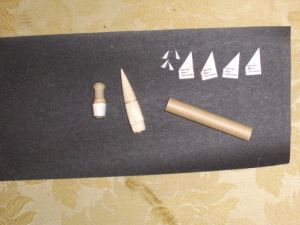Scratch MMX AGM-12B Bullpup Original Design / Scratch Built
Scratch - MMX AGM-12B Bullpup {Scratch}
Contributed by John Partridge
Brief:
The basis for this model was John McCoy's MMX plan sheet found on the MMX Yahoo group. I made a few modifications to John's plans because I didn't know where to find all of the parts and I don't have the tools to make my own. I can't turn nosecones so I went shopping and found one that looked darn close from FlisKits. I also did not have a tail cone and could not find anything commercially made that would work. Instead I used the available dimensions and fabricated the large and small diameters from balsa and cut a paper transition using the transition tool found on EMRR.
Construction:
In the picture you can see the tail cone and engine mount as well as the other parts ready for assembly. I did not have ready-made centering rings, so I made those too, again using the CR tools on EMRR. A caution here, these things are seriously tiny. Balsa simply will not let you cut it this small and remain held together. Each piece had to be papered on both sides and coated with thin superglue in order to be shaped and sanded. This was a lot of work and from now on I will spend the money to buy these parts whenever possible. The fins are also a little difficult to work with because of their size, but papering both sides allowed me to work with them without major hassles.
Finishing:
After assembling the rocket and many, many coats of Testor's paint (sand, paint, repeat), I took the plunge and tried my hand at making my own decals. John McCoy had the format on the MMX Yahoo group but acquiring the needed materials, adapting the plan to use what I had available, learning how to print on decal paper, sealing it and then getting everything applied was a definite challenge for a first timer. I thought it turned out pretty decent.
Flight:
I actually finished this for the Cleveland regional (GLRMR) this Spring (2008) and entered it in the Sport Scale competition (again, my first time). I did pretty well but didn't have the nose weight right. It went unstable off the pad and I didn't have time to fix it. A few weeks later, I entered it as my sport scale entry in the Columbus regional (MMRR). This time with an additional gram of nose weight, it flew fine and I came home with third for sport scale against Patrick Peterson and Chan Stevens from QUARK. I felt pretty good.
Summary:
For a tiny model, I spent a lot of time getting things right, and honestly both times I entered it, the judges were a bit surprised to judge something so small. Some details just were not done. Sanding fin profiles would have been just about impossible at the time but since then I picked up a set of tiny files that might help on the next MMX project. Overall, I had a great time building and flying this model and I'm sure that I will be building more of these wee beasties in the future.
Sponsored Ads
 |
 |














